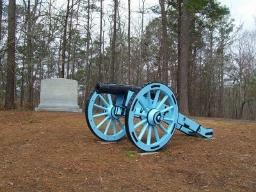 |
| Horseshoe Bend National Military Park |
The Creek War of 1813-1814 had been underway for more than nine months when Major General Andrew Jackson left Fort Williams near present-day Sylacauga with an army of 3,300 men. The general and his men arrived within six miles of the Horseshoe Bend of the Tallapoosa River on the evening of March 26, 1814.
 |
| Tallapoosa River at Horseshoe Bend |
U.S. artillerymen manhandled two cannon - a 3-pounder and a 6-pounder - to the top of a hill overlooking the massive fortification that the Creeks had built to defend their town of Tohopeka ("Horse's Flat Foot"), a village that took its name from the unusual shape of the Horseshoe Bend. As Jackson's troops formed into lines of battle facing the barricades, the gun crews opened fire.
 |
| Site of the Creek fortification |
Among the 1,300 men assigned to Coffee were 600 Cherokee and Creek warriors who had allied themselves with the United States. With the battle in doubt, the Cherokee soldiers swam the river and launched an attack on the rear of the Red Stick line. The famed scholar Sequoyah was part of this attacking force.
 |
| Grave of Major Lemuel Montgomery |
Surging forward, the 39th U.S. Infantry struck the Creek fortifications. Major Lemuel Montgomery was killed and Ensign Sam Houston (later President of Texas) was severely wounded, but the 39th went up and over the wall. Jackson's Tennessee militia troops followed.
 |
| Menawa |
When night fell, the severely wounded war chief crawled out from under a pile of bodies and slipped away. He was disfigured for life. A few of his warriors also managed to swim away, but the Creek Nation would never recover from the devastating defeat.
 |
| Andrew Jackson |
U.S. losses in the battle were 49 killed and 157 wounded. Many of the latter died in the days, weeks and months that followed.
The Battle of Horseshoe Bend did not end the Creek War of 1813-1814, but its outcome was never in doubt after March 27, 1814. The engagement started Andrew Jackson on his road to the White House and the Creek Nation on its journey to the Trail of Tears.
Five months later, the United States forced the Creeks to sign the Treaty of Fort Jackson. The document exacted severe terms on Red Stick and U.S. allied chiefs alike, forcing the cession of 23 million acres of Creek land to the United States.
To learn more about the Battle of Horseshoe Bend, please visit www.exploresouthernhistory.com/AlabamaHSB.
To learn more about the Creek War of 1813-1814, please visit www.exploresouthernhistory.com/creekwar.
To learn more about the Creek Trail of Tears, please visit www.exploresouthernhistory.com/creektrail.
No comments:
Post a Comment